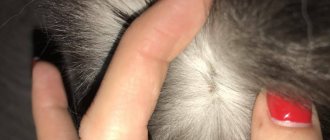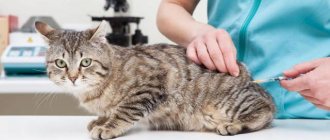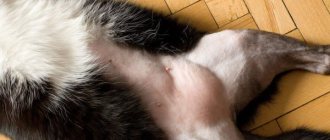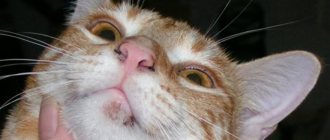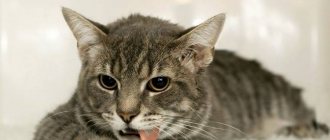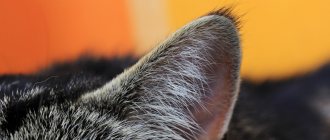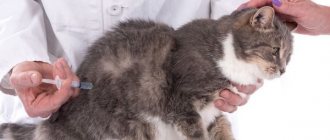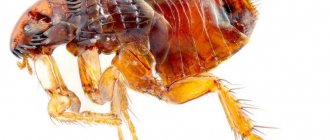Unfortunately, fleas in cats are a common occurrence. Moreover, they can even develop in animals that never leave the apartment. These pests bite pets, cause them pain, and can also infect them with dangerous diseases. Fleas in cats can and should be dealt with. For this, there are both folk remedies and specialized drugs. They have different effectiveness and duration of action, but among all the variety you can choose what will work in a specific case and with a specific cat, taking into account his personal characteristics.
Why and how cats get fleas
A flea is a small blood-sucking insect, the size of which does not exceed 3 mm. She has a flat body and paws with spikes, and the paws are of different lengths. The hind ones are especially long and powerful, they allow fleas to jump a very long distance - half a meter. Considering the size of the flea itself, this is about the same as a jump of two hundred meters for a person.
Fleas are parasites; they live on animals whose blood they feed on.
They easily jump from one victim to another, so it is very easy to pick up fleas while walking. But not all domestic cats go for walks. Many of them never leave the apartment. And even in this case, you can get a parasite. Where do fleas come from in a domestic cat?
- from other animals if they enter the house;
- from owners who can bring insects on their clothes, in a bag of groceries, household items and on shoes;
- from neighbors, from the common corridor and common areas, from where fleas can get there on their own.
Even if you maintain an almost sterile cleanliness in the house, there is no absolute certainty that your cat will not pick up fleas.
Why are fleas dangerous?
These pests feed on the blood of animals. They bite through the skin and suck out blood. In this case, substances are injected into the wound, which prevent the blood from clotting quickly and also cause severe irritation. Flea bites are very itchy, the cat is constantly itching, scratching the wounds, which easily become infected. Fleas bite a wide variety of animals, so they are carriers of pathogens of dangerous diseases. Some of them can be fatal or lead to serious consequences.
Cat fleas do not live on humans, but in the absence of a familiar and more suitable victim they can bite people, which is also dangerous.
Cat flea: who is it and where does it come from?
To understand where cats get fleas from, you should learn more about these parasites: their structure, feeding habits, and life cycle. Fleas are a huge order of wingless insects that are blood-sucking exoparasites and parasitize on any animal. They have a rather narrow specialization: there are fleas of rabbits (Spilopsyllus cuniculi), dogs (Ctenocephalus canis), humans (Pulex irritans) and cats (Ctenocephalides felis). These insects also parasitize rats and birds. Outwardly, they are very similar; only a professional entomologist can determine the exact type of insect.
general description
What does a flea look like on a cat? Their body size ranges from 1 to 5 mm, the cat flea reaches approximately 2 mm. Males are smaller than females. The parasite that has sucked blood increases sharply in size—approximately 2 times. The insect's body is flattened laterally (this makes it easy to move between hairs) and covered with numerous spines and bristles. They help the insect to stay between the hairs of fur or feathers.
The oral apparatus of the parasite is of the piercing-sucking type, which includes a special stylet that pierces the skin of the host. They do not have a proboscis. The limbs of the parasite are strong, they give it the ability to move along surfaces at any angle, as well as make long jumps. The abdomen has special tactile hairs that are sensitive to air vibrations.
They are wingless insects - with their lifestyle, wings would only get in the way of the parasite. The shape of the body and the chitinous cover make mechanical damage to the insect very difficult - it cannot be crushed with your fingers. The parasite can only be destroyed by crushing it with a fingernail on a hard surface.
This is interesting! Fleas are one of the best jumpers in the animal kingdom. Having a size of only a few millimeters, they can jump 19 cm in height and 30 cm in length. This is a hundred times the size of their own body. A person, in order to repeat these results, must long jump 160 meters.
Life cycle
Fleas are insects with a full life cycle; they have the stages of adult insect, egg, larvae and pupae. The female lays her eggs anywhere, and after about two weeks a worm-like larva appears, which grows and molts several times. The larvae live in dust and debris, feeding on decaying organic matter and excrement.
Later, the larva pupates and after a while emerges from the pupa as an adult insect. Now she just needs to find her owner.
The insect's lifespan is approximately 2 years. Parasites reproduce very actively; during her life, the female lays up to 2 thousand eggs.
Cat fleas can also spread to rats, and they displace the rat flea.
Eating habits
Each type of parasite prefers its own host. They adapt to a certain skin structure, its temperature, the composition of the host’s blood and other characteristics. They can feed on the blood of other animals, but they do not do this very willingly.
Although, it should be noted that in this regard the cat flea is the most picky, as it can easily drink both dog and human blood. She is the champion in the number of bites to people.
Typically, these insects do not live permanently on their host. Rather, it serves as their dining room. They attack him from time to time, drink his blood and leave again. They live near their owner. There are some types of fleas that live permanently on their host; these are parasites of nomadic animals.
They feed daily, but can easily endure several months of fasting, after which they pounce on food with particular greed.
This is interesting! Fleas have changed little over the past 50 million years. The fossil insects that scientists studied are almost no different from modern ones. Evolution, apparently, considered that it had already created a masterpiece, which did not make sense to change.
Diseases
Fleas are carriers of serious diseases in humans and domestic animals. Rat pests are especially dangerous. They carry plague, typhus and other serious diseases. In the Middle Ages, entire cities died out from plague epidemics transmitted by rats.
Fortunately, the cat flea does not carry such dangerous diseases, but other types of these insects can live on your pet.
Symptoms of fleas in a cat
It is quite simple to understand that a cat is overcome by fleas. You need to keep an eye on your pet. The following signs indicate the presence of parasites:
- the animal is constantly itching;
- there are small wounds on the skin with dried crusts;
- small black dots can be found in the fur - these are insect excrement;
- You can also see the fleas themselves - they move along the coat, undercoat;
- the animal becomes nervous, restless, sleeps poorly, often wakes up to scratch itself, and its appetite worsens.
Flea removal methods
Insecticides are used to kill insects. These are industrially produced preparations, they are offered in different forms: sprays, drops on the withers, shampoos, collars. They are quite effective, but can also be toxic to the animals themselves. That is why they should not be used to remove fleas from pregnant cats, weakened kittens, and older animals. These drugs can also cause an acute allergic reaction.
Less toxic, but also not as effective, are folk remedies for flea control. In addition, some of these methods are quite complex to implement and require repeated or regular use.
Pharmaceutical preparations for fleas
These include funds in different forms:
- shampoos;
- sprays;
- drops;
- pills.
The choice of product depends on the degree of flea damage, the condition of the animal and the ability to use one or another drug. It's no secret that washing cats is a very difficult task.
Shampoos
The most popular flea remedy. It is relatively safe, but at the same time effective. Shampoo helps get rid of fleas if their number has not reached a critical level, when the entire undercoat is literally swarming with insects. At the initial stage, one wash with a specialized shampoo will be enough.
You can add Ectometrin from Medilis to your regular animal shampoo at the rate of 2 ml per 200 ml of detergent.
Important: you need to use an anti-flea shampoo designed specifically for cats. It is also very important to rinse the wool thoroughly after washing, without leaving even the slightest trace of shampoo on it.
There are flea shampoos that can be used on small kittens.
Sprays
A more convenient drug to use. It can be sprayed outdoors or in a ventilated area. At high concentrations, aerosols are toxic to both the pet and the owner. Flea sprays are only suitable for short-haired cats. With long hair, the drug simply will not achieve its goal.
Alternatively, you can use Ectometrin emulsion from Medilis. It is diluted according to the instructions, applied to the wool with a swab so that the product is absorbed into the skin, and not just into the wool.
Important: when processing, you need to put a cervical collar on the cat so that he does not lick the drug from the fur. It is also necessary to protect your eyes and nose from contact with the insecticide.
Drops
Another popular remedy. It is suitable for treating cats with fur of any length and thickness. Drops are applied to the animal's skin at the withers. Not even the most flexible animal can lick them off the withers. But if there are several animals in the house, they can lick each other, so when processing it is important to separate them to prevent poisoning.
Important: choose drops from trusted manufacturers. These can be “Stronghold”, “Broadline spot on”, “Advocate”, “Advantage”, “Frontline combo”, “Vectra”, “Rolf”. Make sure the product is intended for flea control in cats. It is necessary to strictly follow the instructions and not exceed the prescribed concentration. It is also important for the owner to take care and not allow the product to get on his hands.
Tablets and solutions for injections
This method of control is less known, but there are flea medications for oral administration. Getting into the blood of a pet, they do not harm it, but become destructive for fleas that drink this blood. Flea tablets are usually given to the cat before deworming.
Feeding a cat a pill is quite a difficult task. Therefore, solutions for injection have been developed. The injection must be given by a veterinarian in a clinic setting. It is important to take the appropriate drug and calculate its dose.
Insecticides: Rules for use
Flea allergies in cats can have dire consequences, so it is best to use proven insecticides that will give positive results.
- Under no circumstances should the insecticide come into contact with the cat’s mucous membranes;
- The cat should not reach with its tongue the place where its fur was treated with drops;
- Spray treatment should be carried out carefully; the spray should not come into contact with the cat’s eyes, nose and mouth;
- After treating your pet, you need to ventilate the room;
If the product gets on the mucous membrane, you need to rinse it with plenty of clean water.
Using flea collars
A very popular remedy among cat owners. The collar is impregnated with special preparations that repel fleas. It is effective, but its range of action is very limited, that is, it protects the front of the cat, while the back remains unprotected. It is important that the collar is intended specifically for cats, otherwise the dosage may be too high and the drug may be toxic. Collars need to be changed promptly, as they are valid for no more than a month. You also need to consider that collars can irritate the skin and cause allergies.
A type of collar is a flea keychain for a cat. It is hung on a collar or placed in a house or on a bed where the cat is used to lying. The key fob is battery operated. It emits ultrasound, which is not dangerous to the cat, but repels fleas within a meter radius.
Comparison table of characteristics
In order to compare the products presented, we recommend that you study the comparison table in the article below.
| Means | Pet age (weeks) | Pet weight (kg) | Protection (days) | Active substance | Price, rub) |
| Advocate (Bayer) Drops against scabies mites, fleas and helminths for cats up to 4 kg | from 9 | up to 4 | 28 | imidacloprid, moxidectin | from 405 to 568 |
| Frontline drops against fleas and ticks Combo for cats, kittens, ferrets from 1 kg | from 4 | from 1 | 30 | fipronil | from 440 to 601 |
| Zoetis (Pfizer) Drops against fleas, ticks and helminths Stronghold 45 mg for cats weighing 2.6-7.5 kg | from 1.5 months | from 2.6 to 7.5 | 30 | selamectin | from 1079 to 1563 |
| Inspector drops against fleas and ticks Quadro K for cats from 4 to 8 kg | from 9 | from 4 | 28 | imidacloprid, moxidectin | from 655 to 1777 |
| Apicenna Insectoacaricidal drops Dana Spot-On for carnivores | from 12 | from 4 | 31 | fipronil | from 215 to 248 |
| Helminthal Drops spot-on at the withers for cats less than 4 kg | from 7 | from 1 to 4 | 28 | moxidectin, praziquantel | from 265 to 381 |
| Selafort Drops against fleas, ticks and lice 45 mg for cats weighing 2.6-7.5 kg | from 1.5 months | from 2.5 to 7.5 | 28 | selamectin | from 383 to 407 |
| Beaphar drops against fleas and ticks Veto pure for cats | from 3 months | from 4 | 28 | margosa extract | margosa extract |
| Bravecto (MSD Animal Health) flea and tick drops Spot On for cats 2.8-6.25 kg | from 11 | from 2.8 to 6.2 | 84 | fluralaner | from 800 to 1663 |
| Agrovet protection Drops against fleas, ticks and helminths Dironet Spot-on for cats | from 2 months | from 1 | 28 | praziquantel and ivermectin | from 120 to 430 |
| Advantage (Bayer) Flea drops for cats weighing more than 4 kg, 4 pipettes | from 2.5 months | from 4 | 28 | imidacloprid | from 295 to 1200 |
| Helminthal drops against fleas and ticks Spot-On for cats 4-10 kg for cats from 4 to 10 kg | from 2.5 months | from 4 to 10 | 28 | moxidectin, praziquantel | from 449 to 560 |
| RolfСlub 3D drops against ticks and fleas for cats 8-15 kg | from 3 months | from 8 to 15 | 30 | fipronil, pyriproxyfen, etofenprox | from 296 to 425 |
Traditional methods of fighting fleas
Fleas have been pestering pets for a very long time. During this time, many methods of combating them have emerged. Most are safe for pets, but many are not very effective.
There are also more toxic options. For example, remembering that people used to get rid of lice with kerosene, someone is trying to use it against fleas. This should not be done under any circumstances. This leads to serious poisoning and death of the animal.
Most often, cats are bathed in a decoction of wormwood and rosemary, and soap with wormwood is used for washing. If there are a large number of fleas, these remedies do not help. After using all types of soap, it is important to thoroughly rinse the fur so that your pet does not ingest harmful substances.
Other folk remedies for fleas in cats:
- Bathing in salt water (100 grams of salt per liter). The cat should be placed in a bowl of salt water so that the entire head is on the surface. You need to keep the animal in a salt bath for 10 - 15 minutes, then rinse the fur thoroughly using regular baby soap, dry it and comb it thoroughly to remove dead fleas. The procedure is repeated after 5 – 7 days. Several treatments may be needed. Salt baths can be used to remove parasites from kittens and pregnant cats.
- Treatment with tar soap. You can take liquid soap or lather a solid bar. You should get a thick foam, which is applied to the cat’s entire body and left for 15 minutes, after which the cat can be wrapped in a thick towel. To prevent parasites from scattering around the apartment after removing the towel, it is better to keep the cat in the bath. After the required exposure time, the cat is thoroughly washed, dried and combed. The procedure is repeated a week later.
- Essential oils. They don't kill parasites, but they repel them. Oils with strong odors also do not destroy the eggs that fleas have laid in the fur. The oil is used only in diluted form: 3 – 4 drops are diluted in a glass of water. This water is applied to the cat's fur, trying to saturate the entire coat of the animal down to the skin. You can use oils of pine, cedar, eucalyptus, wormwood, lavender, and anise. You can use essential oils with caution to remove fleas from kittens and pregnant cats, but you need to make sure that the animal does not have individual intolerances or allergies. At the same time as treating with oils, you need to carefully comb out the cat's fur. This way you can reduce the number of fleas by simply removing them mechanically, as well as remove eggs and larvae.
- Wormwood decoction. This plant has a very pungent odor that parasites do not like. Prepare the tincture by pouring five tablespoons of dry leaves into a liter of water and bringing to a boil, simmering over low heat for 20 minutes. The broth is cooled, filtered and the wool is generously moistened with it, then the animal is wrapped in a terry towel for 15 - 20 minutes. Then the wool is washed, dried and combed. This product also does not destroy larvae and eggs; they need to be combed out. A decoction of geranium leaves also works. Both remedies must be used several times.
- Homemade flea shampoo. Take liquid tar soap or diluted in water, add egg yolk, finely chopped onion and wormwood decoction to it. You should get a paste that is applied to the moistened coat, rubbing it into the skin. Then the cat is wrapped in a towel for 20 minutes. After exposure, the wool covering is thoroughly washed and dried, then also thoroughly combed.
A variety of products to protect cats from blood-sucking ticks
You can protect your cat from tick attacks using special veterinary medications. All differ from each other in the principle of action, active substance and method of application.
Drops on the withers
This type of drug cannot be used to treat sick and weakened animals. The principle of action for all drugs is the same: the product accumulates in the upper layer of the epidermis, after which it is gradually released again, forming a protective layer.
The advantages of drops are obvious:
- more economical;
- act on parasites at all stages of development;
- have a wide spectrum of action and are active against various blood-sucking parasites.
Drops should be placed not on the fur, but on the skin.
To protect cats from ticks, the following are used:
- Frontline Spot and Frontline Combo. The drugs effectively protect the animal from fleas for 6 weeks, and ticks and ear mites (otodectosis) for 3 weeks. Frontline Combo also protects your cat from cheyletiella (the mites that cause pityriasis scabies). Drops should be applied pointwise to dry skin between the shoulder blades. The product begins to act after 24 hours after use. Cannot be used on animals under 8 months of age.
Frontline drops are only suitable for cats older than 8 months - Stronghold. The assortment includes drops with different dosages, which are indicated by multi-colored tips. The choice is based on the cat's body weight and the type of parasite. Therefore, to protect against ticks, you can choose a single drug, which will be more effective than a combined one. Drops are applied at the base of the neck or between the shoulder blades. This must be done with gloves. The protection period is 1 month. Already 3 hours after application, the animal can be bathed.
The drug Stronghold should be selected depending on the cat’s body weight - Celandine for fleas and ticks. There are drops for adult cats and kittens (Clandestine Junior). The active ingredients are permethrin and fipronil. It has a significant drawback - it is allergic.
- Inspector. The product contains two active substances - fipronil and moxidectin. The drug allows you to protect the animal from 14 types of parasites (both external and internal), including mites (ixid mites, ear mites, demodectic mites), lice, fleas, etc. It has both a preventive and therapeutic effect, causing paralysis and further death of parasites . The effect of re-infection lasts for 1–2 months.
Inspector drops protect a cat from ticks for up to two months
He is still small, clean, and has never been in nature, so I am sensitive to his health; I wouldn’t want him to be bitten by ticks. These drops are easy to use; you just need to apply drops onto dry, intact skin. You just need to apply it to the skin in places that are inaccessible for licking, such as in the neck area or between the shoulder blades. It is necessary to process no more than every 1 month. Dosage 0.1 ml/kg applied to 3–4 places. Drops of celandine will help destroy not only fleas and ticks, but also lice and lice. Manufacturer CJSC NPF Ecoprom Volume: 3 ampoules of 1 ml. Price: 120 rubles.
Chegla
https://otzovik.com/review_3303180.html
Collars
A tick collar is a flexible strap coated with a repellent or insecticide. After putting it on the animal, the active substance begins to be evenly distributed throughout the coat. To ensure continued protection, it is not recommended to remove the collar.
There are four types of safety collars:
- insecticidal, or gas - a rubber or polyvinyl chloride collar with poisonous impregnation; to activate it, you need to stretch it so that a special capsule bursts and the poison is released; they kill ticks even before the bite is made, but have a slightly toxic effect on the animal itself;
The insecticidal collar is impregnated with a special agent that destroys ticks - radiating - they emit electromagnetic waves that repel parasites, while there is no odor, as well as a toxic effect on cats, but the effect of these waves on the body of mammals has not yet been thoroughly studied;
- ultrasonic - they are a fabric belt with a key fob that emits a sound of a certain frequency, inaccessible to either humans or animals;
Neither people nor animals can hear ultrasound, but it repels insects - herbal (biocollars) - rubber products soaked in essential oils (lavender, citrus, etc.). The main effect is to scare away parasites from the animal, although the effectiveness may be low. Such collars are safe for cats, so they are also suitable for protecting kittens and weakened animals. There is another drawback - the high likelihood of allergies.
I have a cat. It's homey, clean and white. Despite the fact that he does not go outside, in spring and summer fleas somehow sneak in and attack the animal. Fleas also appear after the arrival of a plumber from the housing department. To preserve the purity and nobility of my white cat, as well as to rid him of biting parasites, I always buy him flea collars. At first, the cat didn’t really like the collar and tried to remove it in every possible way, but after a few days he gave up this futile activity. The length of the collar is 35 cm. The smell of the collar is specific, medicinal, impregnated with a special solution. This is understandable, why else would fleas die? Not from a simple piece of rubber. Soon the fleas began to die, and after a week they were no longer visible. I saw several times how a flea crawled onto the tip of the fur and died. The collar served its purpose 100%. After the fleas disappeared, the cat wore it for another six months. I took it off just recently. The collar is domestic, made in the Moscow region, Tomilino village, JSC NPF Ecoprom. I am glad that our people know how to make quality products. For those who care about the condition of their pets, buy a “Clandestine” cat collar against fleas and ticks. You and your pet will be happy. Moreover, the price of such a collar is only 47 rubles.
Ruslan1989
https://otzovik.com/review_1600702.html
In specialized stores, owners are offered the following drugs:
- Hartz. American made collars. They retain their properties even under extreme conditions, for example after getting wet. But the high efficiency is due to the toxicity of the active substance, including for the animal itself. Therefore, such collars can only be worn on healthy adult cats. A wide range allows you to choose a model that will suit both the owner and the cat (in terms of ease of wearing, safety of impregnation, absence of allergies, etc.). These collars are not very popular due to their high price.
The Hartz collar is considered the standard of effective protective collars against ticks - Bolfo and Foresto from Bayer. Collars made in Germany with repellent action. The poison infects parasites through their paws, that is, even before the bite. This is the main advantage of these collars. The poison does not enter the cat’s body, but is evenly distributed over the surface of the skin. Both collars are waterproof and have age and health restrictions for cats. Among the disadvantages is the high cost.
- Beafar. The products of this company are very popular due to the ideal price-quality ratio. Releases a four-step tick protection program:
- destruction of ticks that are already on the animal’s body;
- protection against re-infection (use a collar with margosa extract);
- cleaning the rug, cat house;
- protection against helminthic infestations.
- Leopard. Inexpensive collars with low efficiency. Suitable only for those representatives who appear on the street very rarely. The main active ingredient is fipronil. It belongs to the category of moderate toxicity, therefore it is prohibited for kittens, pregnant and weakened animals.
The Bars collar cannot guarantee 100% protection against ticks
My cat Pussy (Scottish Fold) has had a bit of fleas since she was taken from her breeders. We didn't even notice right away. There are not many of them, only in the area of the head, but they really annoyed my animal in the evenings. I don’t save money on a cat; my whole family loves her very much. Well, then I decided to show off and bought her a Hartz collar to get these bloodsuckers out. I bought Lilac... she's a girl... It's not cheap, about $12. “Probably high quality,” I thought, they make it in the USA, not crap. Somehow they put the collar on Puse's neck (without tightening it), she fiercely resisted, but was “persuaded.” We thought that he was resisting out of habit, and plus the collar had a characteristic smell, which we didn’t like either, not like the cat. She tried for a long time and unsuccessfully to remove it, meowed pitifully, then apparently resigned herself, and only often ran up to the bowl and greedily drank water... Then she tried to go to bed in her place. Then we noticed that the cat began to choke, and immediately interrupted the “experiment.” Pusya was delighted and perked up that the collar had been removed and immediately began to lick herself. If only we knew... In total, the collar was on the cat for about an hour. The next day the cat woke us up 4 hours later than usual (it was a day off). She is very playful with us, but that day she behaved somewhat sluggishly and did not eat well. By lunchtime, she began to huddle, hide in her favorite basket (a secluded place) and eat, and also stopped drinking completely, even refusing her favorite treat, which she usually could not resist. She began to feel nauseous (she constantly swallowed saliva), but did not vomit. We sounded the alarm and immediately took her to the vet. At first they didn’t even think about the collar, they thought that she might have been quietly gnawing on houseplants...
autodetacker
https://otzovik.com/reviews/osheynik_ot_bloh_i_kleschey_hartz_ultra_guard_dlya_koshek/
Sprays
They come in aerosol cans or spray bottles. To protect an animal from tick attacks, its entire body must be treated. This is one of the differences from other protective equipment. Permethrin-based medications are not suitable for cats. If the cat is afraid of the sounds that the spray can makes, then you can apply the product to a cloth, which then wipe the cat’s entire body.
The method of application for all sprays is the same - at a distance of 15 cm from the animal’s body. A complete treatment is one after which the cat's fur is completely wet. It is not recommended to bathe the animal two days before treatment and two days after it.
The most popular anti-tick sprays are:
- Hartz ultra. Destroys and repels ticks and other blood-sucking parasites. The active ingredient is tetrachlorvinphos. After 10 minutes, the cat needs to be dried with a towel and then combed. You cannot bathe the animal for the first two days. After one treatment, all parasites on the body die. Protection lasts for 7 days. Not suitable for use on kittens under 12 weeks of age. It can be used to treat pregnant and weakened animals after consultation with a veterinarian.
Hartz Ultra spray begins to act within 10 minutes after application - Senti Pro. Retains protective properties for two weeks after treatment. The main active ingredient is pyriproxyfen. The application method is classic. You cannot bathe the animal during the first two days.
- Fiprist. It protects the cat for a month, this is one of the main advantages of the drug. In addition, it has no contraindications, that is, this remedy is suitable for pregnant women, lactating women, kittens older than three weeks, and weakened animals. The main active ingredient is fipronil. It is important to follow the dosage (1 squeeze of a bottle per 100 ml - 0.5 ml, per 1 kg of cat's weight - 3-6 ml) and then there will be no side effects.
Fiprist spray can be used to treat pregnant, sick and weakened animals, kittens older than three weeks
We used to drip with a frontline combo and use the same spray. Then somehow there was Dan’s collar. We removed the ticks, but they were just the same, on a binge. For the last year we have been using Barrier standard drops and Hartz Ultra Guard Plus spray with aloe. So the effect of the spray is simply cool. Ticks, as soon as they land on a dog, are paralyzed and within 15 minutes they die (dry out). We have never seen those who got drunk, but those who died on the way to the tasty food were combed out of the wool. :D Spray for forests and all kinds of forest plantations is just right. And thanks to the aloe, it smells very nice. We also use fipronil spray, but it is usually used in the city and only on the paws.
Devilmouse
https://husky.com.ua/forum/threads/305/page-27#post-337293
Shampoos
Shampoos contain the same active substances as drops and sprays, but in lower concentrations. The main advantage is instant action. If the drops or collar begin to act only after a certain time, since activation or time is needed for the drug to be distributed throughout the cat’s body, then the shampoo kills parasites immediately after application to the cat.
It is not recommended to bathe a cat more than once a month.
Shampoo is a first aid product. My cat (Scottish fold) came from the street. I noticed that she was really itching. I go to her, and there is a “neighbor”. I bought shampoo a long time ago, as soon as Matilda appeared, but the shampoo was not specifically for ticks, but for parasites. To be honest, I didn’t really hope for an effect, but I was pleasantly surprised - the “neighbor” fell off. After washing, I additionally treated the cat with drops. There were no more such troubles.
It is important to choose the right shampoo. The choice is influenced by:
- coat type and length;
- composition of the product (fluffy cats are more susceptible to chemicals than hairless cats due to the smaller number of sweat glands they have, so shampoos with sodium sulfoethoxylate are suitable for the former);
- the presence of components that care for the coat (sodium sulfoethoxylate, methionine, antistatic agents).
It is preferable to choose concentrated shampoos; they are more effective than their liquid counterparts.
It is often forbidden to bathe an animal. It is better to do this no more often than once a month, but no less than once every two months. The frequency depends on the presence of parasites on the body.
The most effective means are:
- Barsik. Inexpensive but effective remedy. In addition to killing parasites, it takes excellent care of the coat and makes it shiny. It is highly effective, so large intervals can be made between treatments - 2-3 months. Suitable for all wool types.
- Phytoelite. It has a double effect on parasites: contact (the poison enters through the integument of the parasites after contact with the skin and fur of the animal) and intestinal (poisoning occurs when trying to bite a cat). It is absolutely safe for cats. The composition contains plant components that have a beneficial effect on the condition of the animal's coat.
- Celandine. The main advantage is that it can be used for animals of any age, which is especially important for those owners who have a cat with “children.” Effectively fights parasites, softens hair and skin, and does not irritate the eyes.
Celandine shampoo effectively destroys parasites and cares for the coat
When I got myself a cat, I swore that she would not go outside and would be purely a pet, but circumstances turned out so that I had to take her to my parents in the village. There is a private house there and in addition to my 2 other cats, I was very worried that due to the move she would pick up some parasites. I decided to protect my girl. Arriving at the pet store, I asked for flea and tick shampoo. Without hesitation, I took the first thing the seller gave me. When I came home I saw that the shampoo was “Clandestine”, the name was familiar to me. I washed the cat thoroughly. And more calmly she sent her to the village. After 2 weeks I came to visit my pet, and what do you think? I was amazed that the fur was completely clean and smooth, and there were no parasites. Although she was almost constantly outside and the other cats in the house were itching from fleas. When I left, I washed it again. So, every 2 weeks we use this shampoo. I'm happy with the result! I also bought myself a collar from this series)
Pirozhenka94
https://otzovik.com/review_282916.html
Tablets and injections
Tablets and injections are not so popular in Russia, but nevertheless they are no less effective. When taken orally, the active substance enters the animal’s systemic bloodstream, and therefore, after a bite, into the body of the parasite. But only adult individuals can be destroyed in this way, so it is recommended to combine the tablets with other types of drugs. The product can be used to treat kittens over 4 weeks of age.
Only one remedy in the form of tablets will help you get rid of ticks - Tsapstar. Its basis is the insecticide nitenpyram, which has a neuroleptic effect. Give the tablets to the cat during meals. The drug begins to act within 10–20 minutes, maximum activity is achieved after 2–4 hours, and effectiveness remains throughout the day, so the tablets cannot be used as a prophylactic agent. Tsapstar has no side effects, so pregnant and lactating females are allowed to take it.
Comfortis can also help against blood-sucking parasites, but these tablets are effective against fleas. In addition, the drug has a large number of contraindications, for example, pregnant cats, weakened and old animals, and kittens under three months should not take it. There are also side effects: lethargy, nausea, vomiting.
In veterinary medicine, injections are also used to kill ticks and other blood-sucking parasites, but this is done extremely rarely. This type of protective medication is a professional one, so injections should only be given by a veterinarian.
Ointments and gels
Ointments are one of the most effective means in the fight against ticks, but only against subcutaneous ticks (demodex). Ointments are applied locally. Their advantage is that they are able to fight the consequences of blood-sucking attacks and soothe inflammation from bites on the skin.
Effective in the fight against ticks are:
- Aversectin ointment. It is a yellowish fatty substance with a faint odor. It has a detrimental effect on parasites at all stages of life: both larvae and mature individuals. It affects the nervous system of the parasite, which causes its death. It has a local effect and is eliminated within 10 days. The ointment should be used as follows. Trim the hair on the problem area, then remove dirt and scabs from the skin, only then apply the ointment to the skin, moving from the edges to the center. The animal must be protected from licking the ointment using a special cap.
Aversectin ointment acts on the nervous system of the parasite - Novertin ointment. The active ingredient is aversectin C. It is a homogeneous thick mass with a faint odor. The color can range from light yellow to light brown. The animal is treated twice with an interval of 7–10 days. The product should be applied to a place inaccessible to licking, for example on the withers, between the shoulder blades. The ointment should not be used to treat pregnant or sick animals.
- Amidel-Gel. Contains three active ingredients: amitraz, methyluracil, lidocaine hydrochloride. The drug affects the nervous system of ticks, has a local anesthetic effect, and promotes rapid healing of the skin after a parasite bite. To kill ticks, use a syringe to squeeze out 0.5 ml of the drug per 1 kg of cat’s body weight. To prevent licking, you can put a muzzle or cap on the animal. Do not use on kittens under 2 weeks of age, sick or malnourished animals. It is not recommended to combine with other insecto-acaricidal agents. You only need to carry out the treatment while wearing gloves, and wash your hands thoroughly after the procedure. For 24 hours after treatment, you should not pet the animal or allow children near it.
Amidel-Gel can only be applied with gloves
But one morning I was going to work, and I heard a familiar squeak, and this is my Chernysh)) He was already sitting at the bus stop with his butt in the snow and screaming, already clearly weakened. My heart could not stand such a test, I grabbed him and went home))) I put him in our bathhouse, it was warm there, fed him and ran to work. I was late, of course, but this is nonsense) I deliberately isolated him for a while until I took him to the clinic, since I already have a cat at home. In the evening when I came to see him, I noticed that he was scratching his ears and often tucking them in. In the morning we went with him to the doctor, it turned out that he had ear mites and an inflammatory process in the testicles, apparently from sitting in the snow (The doctor prescribed him treatment with this ointment and we were treated for a month. The ointment is very effective, easy to use, not expensive. treatment, they did a second examination, which showed that the cat is healthy! Now all his illnesses are in the past, castration has been carried out, vaccination too))) He lives with my girlfriend and enjoys life, this is our common boy)
Lyudmilabagira 98
https://otzovik.com/review_3169039.html
Traditional methods
Many essential oils have a pungent odor that can repel ticks. These oils include:
- eucalyptus;
- lavender;
- mint;
- rosemary;
- geranium;
- thyme.
To prepare a remedy for ticks, you need to take any essential oil (one or more) as a base ingredient and mix it with alcohol or vinegar (plays the role of an emulsifier) and water. When using alcohol, the preparation process is as follows:
- Mix 2 tsp. geranium oil and medical alcohol.
- Then add 1 tbsp. water. Mix the ingredients in a closed bottle, in which the mixture can be stored for 6 months.
- To protect against ticks, you need to spray things or animal fur.
When using vinegar, the proportions are slightly different:
- 10–15 drops of essential oil;
- 4 tsp. vinegar;
- 2 tsp. water.
The process of preparing the product is the same.
Video: veterinarian on how to choose a tick repellent
What else needs to be done at home
If not only the animal is infected with fleas, but also the apartment in which it lives, the entire home must be treated. Eggs and insects may be present in the cat's bedding or house, on clothes and shoes, and household items. Therefore, along with treating the cat, it is necessary to disinfest the apartment.
Before processing the apartment, a thorough cleaning of the room is necessary. Wash at a temperature of 60 degrees all textiles that can be washed: curtains, bedspreads, blankets, rugs, pillows. It is also advisable to iron all textiles or fry them in the sun. If possible, it is better to treat everything with a steam cleaner. You need to wash all your shoes, wash or dry-clean your outerwear, hats, and scarves.
Then they are treated with an insecticide. It can be in the form of a spray or solution for spraying and wiping surfaces. It is sprayed throughout the room, especially attention should be paid to baseboards, floors, and furniture standing on the floor. It is also advisable to treat upholstered furniture. To treat premises against fleas, you can use insectoacaricides from Medilis: Malathion, Permifen, Super, Cyper, Neo. They destroy not only fleas, but also other parasites unwanted by humans. However, it is necessary to strictly follow the instructions when preparing working solutions and using them.
After the exposure time specified in the instructions has passed, furniture, carpets, floors and other surfaces are vacuumed to remove dead insects. After this, you can wash the floors and other surfaces with water with the addition of strong-smelling essential oils, such as pine or wormwood.
All processing is carried out observing safety precautions. There should be no animals or people in the room. After applying the product, you need to leave the apartment for several hours, and then thoroughly ventilate the entire apartment.
Risk factors
The fleas that infect cats live in the grass. From there they jump on warm-blooded animals and feed on their blood. These blood-sucking parasites live on all continents, even Antarctica. A cat can become infected with fleas at any time of the year.
It is important to remember the reasons why a cat is at risk of contracting parasites:
- A cat that goes outside will definitely become infected with fleas. Therefore, you should not let your pet walk on its own.
- Unlike cats, domestic dogs should be walked 2-3 times a day. If a dog brings fleas home, then all other animals will pick them up. All pets should be treated for fleas regularly.
- A person can bring fleas into an apartment on his shoes or outerwear. Only regular treatment with anti-flea products will protect your pet.
- If the cat already had fleas, but the owner did not treat the pet, then the parasites will soon appear again. Fleas lay eggs in animal fur. New parasites can hatch from these eggs at any time.
- Fleas that have already entered the apartment will settle in the thick carpet. All carpets and cat beds should be thoroughly vacuumed.
- Fleas multiply especially actively in the heat, so in the summer you will have to treat your cat several times.
Flea infestations often lead to serious complications that are detrimental to the health of cats. Flea bites always cause severe pain and excruciating itching, and also provoke the development of dangerous diseases.
Complications of flea bites:
- Anemia is a condition in which a cat does not have enough blood due to a large number of parasites. The level of hemoglobin in the blood is greatly reduced. It develops when cats are not treated for fleas. Street animals are most often affected. Very young kittens, as well as weakened, sick and elderly animals can die from anemia.
- Flea dermatitis is an allergic reaction to the saliva of parasites that enters the skin during a bite. The pet experiences severe skin irritation, so the cat constantly licks. Her hair falls out and her skin becomes crusty. Infection easily penetrates damaged skin, which can lead to blood poisoning.
- Infectious diseases - fleas can infect pets with bartonellosis or rickettsia.
- Tapeworms - by licking, a cat can swallow fleas infected with tapeworms. Because of this, worms will begin to multiply in the intestines, the pet’s well-being will worsen, and then it will have to be treated not only for fleas, but also for worms.
Parasites are especially dangerous for pregnant and lactating cats. Fleas can harm not only the mother, but also the future offspring. But during pregnancy and lactation, you cannot treat your cat with anti-flea agents, because they are toxic. Treatment must be carried out before mating.
Up to 200 fleas can live on one cat. A caring owner should treat pets for parasites 4 times a year - every 3 months. If your cat has fleas, you need to carry out additional treatment.
We recommend the article: Why the cat’s eye is cloudy: causes, treatment methods
How to remove fleas from a pregnant cat
Pregnant and lactating cats also suffer from fleas. They must be removed, as infection with parasites affects the development of kittens. It is important that the products are non-toxic. It is better if the drug is selected by a veterinarian after assessing the animal’s condition. For treatment, sprays or drops are used on the withers. The preparations must contain an indication of the possibility of use on pregnant and lactating animals.
Shampoos, drops on the withers and sprays are also used to treat kittens. There are products that can be used within a couple of days after the kitten is born.
User rating
Advocate (Bayer) Drops against scabies mites, fleas and helminths for cats up to 4 kg
Frontline drops against fleas and ticks Combo for cats, kittens, ferrets from 1 kg
Zoetis (Pfizer) Drops against fleas, ticks and helminths Stronghold 45 mg for cats weighing 2.6-7.5 kg
Inspector drops against fleas and ticks Quadro K for cats from 4 to 8 kg
Apicenna Insectoacaricidal drops Dana Spot-On for carnivores
Helminthal Drops spot-on at the withers for cats less than 4 kg
Selafort Drops against fleas, ticks and lice 45 mg for cats weighing 2.6-7.5 kg
Beaphar drops against fleas and ticks Veto pure for cats
Bravecto (MSD Animal Health) flea and tick drops Spot On for cats 2.8-6.25 kg
Agrovet protection Drops against fleas, ticks and helminths Dironet Spot-on for cats
Advantage (Bayer) Flea drops for cats weighing more than 4 kg, 4 pipettes
Helminthal drops against fleas and ticks Spot-On for cats 4-10 kg for cats from 4 to 10 kg
RolfСlub 3D drops against ticks and fleas for cats 8-15 kg
Preventing flea infestation
There is no absolute protection against fleas. But you can reduce the likelihood of infection. To do this, you need to take the following measures:
- for prevention, apply drops to the withers every two months or six months, as indicated in the instructions;
- do not let the cat go outside;
- regularly take the animal to the veterinarian, who can detect parasites in time.
If it is known that there are fleas in the house, which is especially true in older buildings, it is worth using pest control products to treat the apartment from time to time.
If a cat walks outside, it makes sense to vaccinate it. Once a year, a vaccination is given that protects the pet from pests. Vaccination is done only in a veterinary office.
Room treatment
The same groups of drugs are used as for treating animals. FOS and cyanopyrethroids have proven themselves well for treating premises. But first, mechanical cleaning is used with a vacuum cleaner (paying special attention to cracks, upholstered furniture, back walls of cabinet furniture), wet cleaning and only then products. You can use several drugs at the same time, or you can use just one. Keep in mind: you will need both a liquid diluted in water to wash the floor so that the water and product flows into the cracks, and sprays. If the flooring is sensitive to excessive moisture, then a spray can be used to treat the baseboards.
